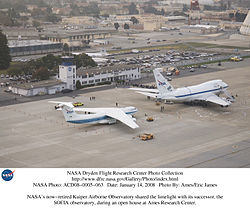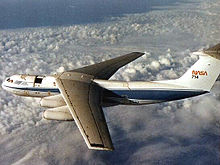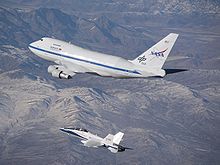- Luftgestützte Astronomie
-
Als Luftgestützte Astronomie (engl. airborne astronomy) werden astronomische Projekte bezeichnet, bei denen Teleskope und andere Messinstrumente in Luftfahrzeuge eingebaut und in großen Höhen als Beobachtungsplattformen betrieben werden.
Inhaltsverzeichnis
Geschichte und Projekte
Seit den 1920er Jahren werden Forschungsballone und Flugzeuge verwendet um astronomische Beobachtungsmissionen durchzuführen.[1] Verschiedene Flugzeugtypen wurden verwendet, u.a. ein Flugboot Felixstowe F5L. Für moderne luftgestützte Programme wurden u.a. Learjet 24, Lockheed C-141, McDonnell Douglas F/A-18 und Boeing 747 adaptiert.[2] [3] [4]
Einige Programme, wie z.B. das Lear Jet Observatory und das Kuiper Airborne Observatory wurden erfolgreich beendet.[5][6] Ein aktuelles Programm ist das Stratospheric Observatory For Infrared Astronomy, bei dem ein Infrarotteleskop in eine Boeing 747 SP integriert wurde. Beobachtungsflüge in Höhen von 12-14 km werden damit durchgeführt. [7] [8]
Projekte, die ballongetragene Teleskope verwendeten waren z.B. Stratoscope, Sunrise, Far Infrared Interferometric Telescope und BOOMERanG.
Siehe auch
Literatur
- Wendy Whiting Dole: Milestones in Airborne Astronomy - From the 1920's to the Present. NASA Ames Research Center, 1997 Abstract, pdf online
- Michael R. Haas: Airborne Astronomy Symposium on the Galactic Ecosystem - From Gas to Stars to Dust. Astronomical Soc. of the Pacific, San Francisco 1995, ISBN 0-937707-92-9.
- Daniel D. Durdaa, et al.: SWUIS-A - A Versatile, Low-Cost UV/VIS/IR Imaging System for Airborne Astronomy and Aeronomy Research. pdf online
- Barb Mulkin: "In Flight - The Story of Los Alamos Eclipse Missions." Los Alamos Science, pdf online
Weblinks
- SOFIA - The Future of Airborne Astronomy sofia.usra.edu
- SOFIA science center Educational Materials
- SWUIS-A Airborne Occultation Demonstration Project Southwest Research Institute Planetary Science Directorate
Einzelnachweise
- ↑ Wendy Whiting Dole: Milestones in Airborne Astronomy -From the 1920's to the Present sofia.usra.edu (pdf)
- ↑ Innovative Airborne Astronomy Capability Now Operational boulder.swri.edu
- ↑ DRYDEN F-18s FLY AIRBORNE ASTRONOMY OCCULTATION EXPERIMENT NASA Dryden News Releases, 23. Februar 2000 (Abgerufen am 15. Juni 2010); F-18 Airborne Astronomy dfrc.nasa.gov; Boeing NC-135 Airborne astronomy missionsen.wikipedia
- ↑ http://airborne.seti.org/ airborne@seti institute
- ↑ LEAR JET OBSERVATORY AND KUIPER AIRBORNE OBSERVATORY PUBLICATIONS sofia.usra.edu (Abgerufen am 18. Juni 2010)
- ↑ Ames Research Center: A Complete Service Center for Airborne Earth Observation gsfc.nasa.gov, abgerufen am 14. August 2011
- ↑ DLR-Webcast SOFIA - Das fliegende Infrarot-Observatorium dlr.de, 26. Mai 2010
- ↑ First Light- Erster Beobachtungsflug von SOFIA dlr.de, 28. Mai 2010 (Abgerufen am 14. Juni 2010)
Wikimedia Foundation.





